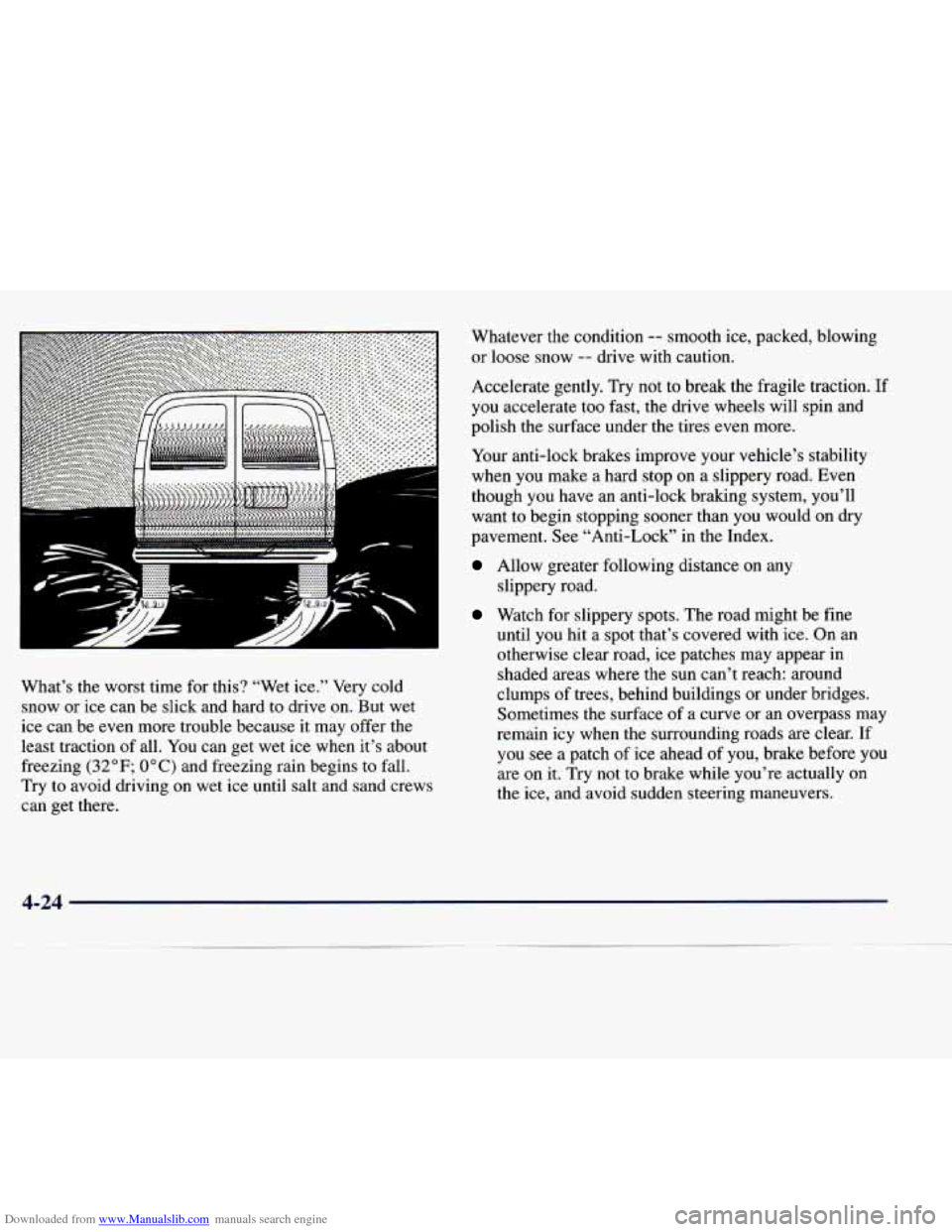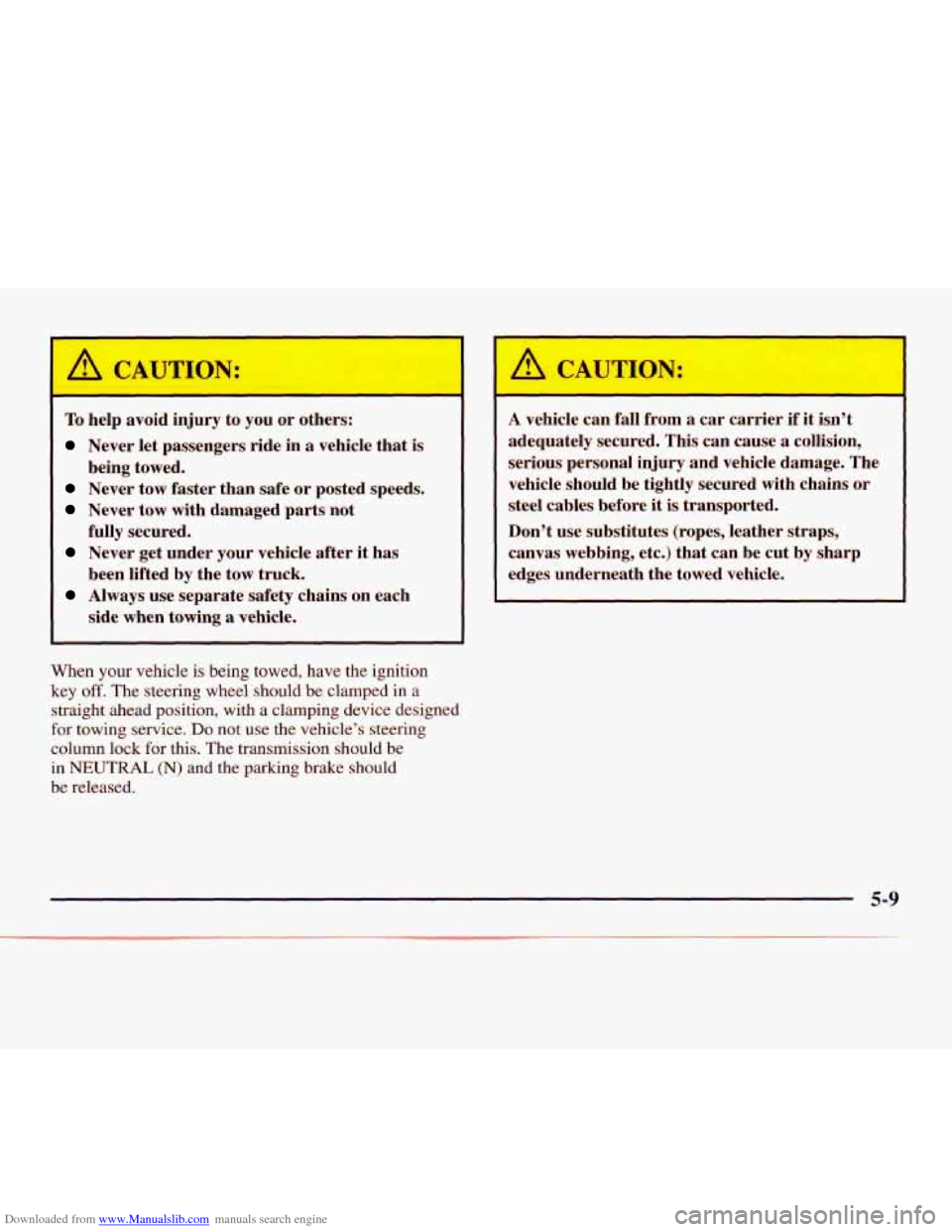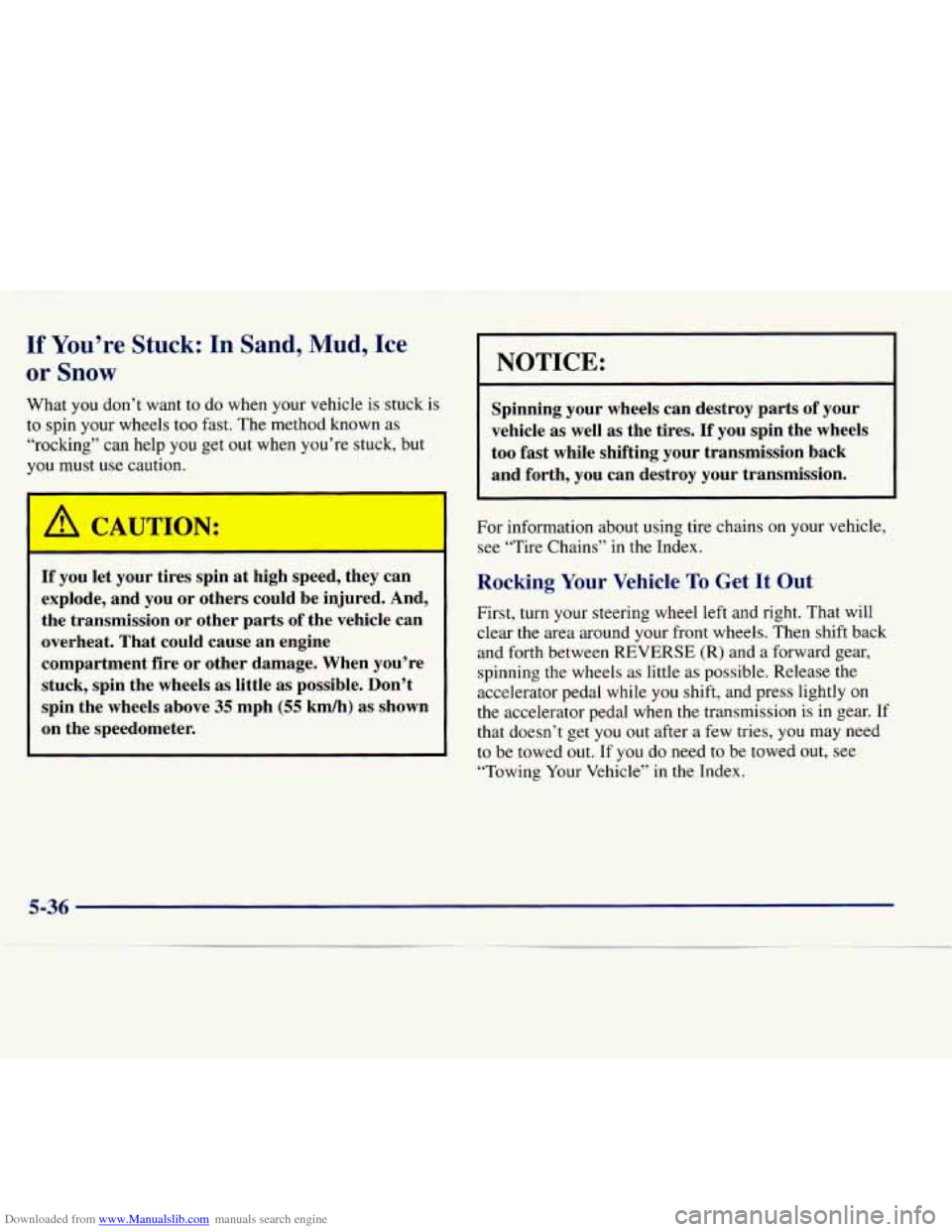1998 CHEVROLET EXPRESS steering wheel
[x] Cancel search: steering wheelPage 187 of 386

Downloaded from www.Manualslib.com manuals search engine What’s the worst time for this? “Wet ice.” Very cold
snow or ice can be slick and hard to drive on. But wet
ice can be even more trouble because it
may offer the
least traction of all. You can get wet ice when it’s about
freezing
(32°F; OOC) and freezing rain begins to fall.
Try to avoid driving on wet ice until salt
and sand crews
can get there. Whatever
the condition
-- smooth ice, packed, blowing
or loose snow -- drive with caution.
Accelerate gently. Try not to break the fragile traction.
If
you accelerate too fast, the drive wheels will spin and
polish the surface under the tires even more.
Your anti-lock brakes improve your vehicle’s stability
when you make a hard stop on a slippery road. Even
though you
have an anti-lock braking system, you’ll
want to begin stopping sooner
than you would on dry
pavement. See “Anti-Lock” in the Index.
Allow greater following distance on any
slippery road.
Watch for slippery spots. The road might be fine
until you
hit a spot that’s covered with ice. On an
otherwise clear road, ice patches may appear in
shaded areas where the
sun can’t reach: around
clumps of trees, behind buildings or under bridges.
Sometimes the surface
of a curve or an overpass may
remain
icy when the surrounding roads are clear. If
you see a patch of ice ahead of you, brake before you
are on it. Try not to brake while you’re actually on
the ice, and avoid sudden steering maneuvers.
4-24
Page 197 of 386

Downloaded from www.Manualslib.com manuals search engine Towing a trailer requires a certain amount of experience.
Before setting
out for the open road, you’ll want to get
to know your rig. Acquaint yourself with the feel of
handling and braking with the added weight
of the
trailer. And always keep in mind that the vehicle
you are
driving is now a good deal longer and
not nearly as
responsive as your vehicle is by itself.
Before
you start, check the trailer hitch and platform
(and attachments), safety chains, electrical connector,
lamps, tires and mirror adjustment.
If the trailer has
electric brakes, start your vehicle and trailer moving and
then apply the trailer brake controller by hand to be sure
the brakes are working. This lets
you check your
electrical connection
at the same time.
During your trip, check occasionally to be sure that the
load is secure, and that the lamps and any trailer brakes
are still working.
Following Distance
Stay at least twice as far behind the vehicle ahead as you
would when driving your vehicle without a trailer. This
can help you avoid situations that require heavy braking
and sudden turns.
Passing
You’ll need more passing distance up ahead when
you’re towing a trailer. And, because you’re a good deal
longer, you’ll need
to go much farther beyond the
passed vehicle before you can return
to your lane.
Backing Up
Hold the bottom of the steering wheel with one hand.
Then, to move
the trailer to the left, just move that hand
to the left. To move the trailer to the right, move your
hand to the right. Always back up slowly and, if
possible, have someone guide you.
Page 210 of 386

Downloaded from www.Manualslib.com manuals search engine A CAUTWN:
To help avoid injury to you or others:
Never let passengers ride in a vehicle that is
Never tow faster than safe or posted speeds.
Never tow with damaged parts not
Never get under your vehicle after it has
Always use separate safety chains on each
being
towed.
fully secured. been lifted by the tow truck.
side when towing
a vehicle.
When your vehicle is being towed, have the ignition
key
off. The steering wheel should be clamped in a
straight ahead position, with a clamping device designed
for towing service.
Do not use the vehicle’s steering
column lock for this. The transmission should be
in
NEUTRAL (N) and the parking brake should
be released.
I
A vehicle can fall from a car carrier if it isn’t
adequately secured. This can cause
a collision,
serious personal injury and vehicle damage. The
vehicle should be tightly secured with chains or
steel cables before
it is transported.
Don’t use substitutes (ropes, leather straps,
canvas webbing, etc.) that can be cut by sharp
edges underneath the towed vehicle.
5-9
Page 222 of 386

Downloaded from www.Manualslib.com manuals search engine Engine Fan Noise If a Tire Goes Flat
Your vehicle has a clutched engine cooling fan. When the
clutch is engaged, the
fan spins faster to provide more air
to cool the engine. In most everyday driving conditions,
the fan is spinning slower and the clutch is not fully
engaged. This improves fuel economy and reduces fan
noise. Under heavy vehicle loading, trailer towing and/or
high outside temperatures, the fan speed increases as the
clutch more fully engages.
So you may hear an increase in
fan
noise. This is normal and should not be mistaken as
the transmission slipping or making extra shifts. It is
merely the cooling system functioning properly. The fan will slow down when additional cooling is not required and the clutch partially disengages.
You may also hear this fan noise when you start
the engine. It will go away as the fan clutch
partially disengages. It’s unusual
for
a tire to “blow out” while you’re driving,
especially if you maintain your tires properly. If air goes
out of a tire, it’s much more likely to leak out slowly.
But if
you should ever have a “blowout,” here are a few
tips about what to expect and what
to do:
If a front tire fails, the flat tire will create a drag that
pulls the vehicle toward that side. Take your foot off the
accelerator pedal and grip the steering wheel firmly.
Steer to maintain lane position, and then gently brake
to
a stop well out of the traffic lane.
A rear blowout, particularly on a curve, acts much like a
skid and may require the same correction you’d
use in a
skid. In any rear blowout, remove your foot from the
accelerator pedal. Get the vehicle under control by
steering the way you want the vehicle to go.
It may be
very bumpy and noisy, but you can still steer. Gently
brake
to a stop -- well off the road if possible.
If
a tire goes flat, the next part shows how to use your
jacking equipment
to change a flat tire safely.
Page 237 of 386

Downloaded from www.Manualslib.com manuals search engine If You’re Stuck: In Sand, Mud, Ice
or Snow
What you don’t want to do when your vehicle is stuck is
to spin your wheels too fast. The method known as
“rocking” can help you get
out when you’re stuck, but
you must
use caution.
1 A CAUTION:
1
If you let your tires spin at high speed, they can
explode, and you or others could be injured. And,
the transmission or other parts of the vehicle can
overheat. That could cause an engine
compartment fire or other damage. When you’re
stuck, spin the wheels as little
as possible. Don’t
spin the wheels above
35 mph (55 km/h) as shown
on the speedometer.
I NOTICE:
Spinning your wheels can destroy parts of your
vehicle as well as the tires.
If you spin the wheels
too fast while shifting your transmission back
and forth, you can destroy your transmission.
For information about using tire chains
on your vehicle,
see “Tire Chains” in the Index.
Rocking Your Vehi :o Get It Out
First, turn your steering wheel left and right. That will
clear the area around your front wheels. Then shift back
and forth between REVERSE
(R) and a forward gear,
spinning the wheels
as little as possible. Release the
accelerator pedal while
you shift, and press lightly on
the accelerator pedal when the transmission is in gear. If
that doesn’t get
you out after a few tries, you may need
to be towed
out. If you do need to be towed out, see
“Towing Your Vehicle” in the Index.
5-36
Page 240 of 386

Downloaded from www.Manualslib.com manuals search engine Section 6 Service and Appearance Care
Here you will find information about the care of your vehicle. This section begins with service and fuel information,
and then it shows how to check important fluid and lubricant levels. There is also technical information about your
vehicle, and a part devoted to its appearance care.
6- 2
6-3
6-5
6-5
6-7
6-
8
6-11
6- 12
6-
16
6- 17
6-2 1
6-2 1
6-24
6-25
6-25
6-26
6-27
6-3
1
Service
Fuel (Gasoline Engine)
Fuels in Foreign Countries (Gasoline Engines)
Filling Your Tank (Gasoline Engine)
Filling a Portable Fuel Container
Checking Things Under the
Hood
Noise Control System
Engine Oil (Gasoline Engine)
Air Cleaner (Gasoline Engines)
Automatic Transmission Fluid
Rear Axle
Engine Coolant
Radiator Pressure Cap
Thermostat
Power Steering Fluid
Windshield Washer Fluid
Brakes Battery 6-32
6-32
6-40
6-4
1
6-5 1
6-5 1 6-55
6-56
6-57
6-57
6-57
6-59
6-60
6-6
1
6-66
6-67
6- 69 Bulb Replacement
Halogen Bulbs
Windshield Wiper Blade Replacement
Tires Appearance Care
Cleaning the Inside of Your Vehicle
Cleaning the Outside
of Your Vehicle
Cleaning Aluminum Wheels (If Equipped)
Cleaning Tires
Sheet Metal Damage
Finish Damage Appearance Care Materials Chart
Vehicle Identification Number (VIN)
Electrical System
Replacement Bulbs Capacities and Specifications
Normal Maintenance Replacement Parts
Page 380 of 386

Downloaded from www.Manualslib.com manuals search engine Off-Road Recovery ............................. 4- 1 1
Oil. Engine .................................... 6-12
Overheating Engine
............................. 5- 1 1
Owner Checks and Services ....................... 7-38
Owner Publications. Ordering
................ 8- 1 1. 8- I2
Paint Spotting. Chemical
........................ 6-58
Park Automatic Transmission
....................... 2-21
Shifting Into
................................. 2-25
Shifting Out of
............................... 2-28
AtNight
.................................... 2-15
Brake ...................................... 2-24
BrakeMechanismCheck
....................... 7-41
Over Things That Burn
........................ 2-29
With a Trailer
................................ 4-36
Passenger Position
.............................. 1-26
Passing
................................... 4-11
Passlock
..................................... 2-16
Periodic Maintenance Inspections
.................. 7-42
Power
Antenna Mast Care
............................ 3-27
DoorLocks
................................... 2-5
Remote Control Mirror
........................ 2-45
Seat
......................................... 1-3
Steering
..................................... 4-8
Steering Fluid
................................ 6-25
Windows
................................... 2-31
Pregnancy. Use
of Safety Belts .................... 1-25
Parking
Lots
....................................... 2-16
8 *.
Problems on the Road ............................ 5-1
Publications. Service and Owner
.............. 8- 1 1. 8- 12
Radiator
..................................... 5-18
Radiator Pressure Cap ........................... 6-24
Radio Reception
................................ 3-23
Radios
.......................... 3-7.3-9.3-11. 3- 16
Rain. Driving In
................................ 4-15
Reading Lamps
................................ 2-43
Rear Axle
....................................... 6-21
Door Security Locks
........................... 2-5
Outside Seat Position
.......................... 1-34
Seatpassengers
.............................. 1-34
Towing
..................................... 5-11
Rear Air Conditioning and Rear Heater
............... 3-5
Rear Heater Controls (without Air Conditioning)
....... 3-4
Rear Passenger Temperature Control
................. 3-5
Rear Safety Belt Comfort Guides
.................. 1-37
Rearview Mirror
................................ 2-45
Reclining Front Seatbacks
......................... 1-3
Recommended Fluids and Lubricants
............... 7-44
Recovery Tank. Coolant
.......................... 5-16
Refrigerants. Air Conditioning
.................... 6-70
Remote Compact Disc Player
..................... 3-20
Replacement Bulbs
...................................... 6-66
Parts
....................................... 6-69
Wheel
...................................... 6-49
Replacing Safety
Belts ........................... 1-62
Reporting Safety Defects
.................... 8- 10. 8- 1 1
9-7
Page 382 of 386

Downloaded from www.Manualslib.com manuals search engine Service and Appearance Care ...................... 6-1
Service and Owner Publications .............. 8- 11. 8- 12
Service Publications
........................ 8- 1 1. 8. 12
Servicing Your Air Bag-Equipped Vehicle
........... 1-32
Sheet Metal Damage
............................ 6-57
ShiftLever
............................... 2.21. 2.25
Shifting
Automatic Transmission
....................... 2-21
Into Park (P)
................................. 2-25
OutofPark
.................................. 2-28
Shoulder Belt Height Adjuster
..................... 1 . 19
Sidemarker Lamp Bulb Replacement
............... 6-36
SignalingTurns
................................ 2-35
Specifications and Capacities
...................... 6-67
Speech Impaired. Customer Assistance
............... 8-4
Speedometer
................................... 2-52
Stains. Cleaning
................................ 6-52
Starter Switch Check
............................ 7-40
Starting Your Engine
............................ 2- 18
Steam
........................................ 5-12
Steering
....................................... 4-8
In Emergencies
............................... 4-10
Power
....................................... 4-8
Speed Sensitive
............................... 4-9
Tips
......................................... 4-9
Wheel. Tilt
.................................. 2-34
StorageAreas
.................................. 2-48
Storage. Vehicle
................................ 6-3 1
Stuck: In Sand. Mud. Ice or Snow .................. 5-36
SunVisors .................................... 2-49
Symbols. Vehicle
.................................. v
Skidding ...................................... 4-13 Taillamp
Bulb Replacement
...................... 6-37
TapePlayerCare
............................... 3-25
Temperature Control. Rear Passenger
................ 3-5
Theft ......................................... 2-15
Theft-Deterrent Feature
.......................... 3-21
Thermostat
.................................... 6-25
Third Gear. Automatic Transmission
................ 2-23
Tilt Steering Wheel
............................. 2-34
Time. Setting the
................................ 3-7
Tirechains
.................................... 6-50
TireLoading ................................... 4-27
Tire-Loading Information Label
................... 4-27
Tires
......................................... 6-41
Alignment and Balance
........................ 6-48
BuyingNew
................................. 6-46
Chains
..................................... 6-50
ChangingaFlat
.............................. 5-22
Cleaning
.................................... 6-57
Dual Operation
............................... 6-45
Inflation
.................................... 6-42
Inflation Check
............................... 7-38
Inspection and Rotation
........................ 6-43
Loading
.................................... 4-27
Pressure
.................................... 6-42
Temperature
................................. 6-48
Traction
.................................... 6-48
Treadwear
................................... 6-47
Uniform Quality Grading
....................... 6-47
Wear Indicators
.............................. 6-45
Wheel Replacement
........................... 6-49
When It’s Time for New
....................... 6-45
TopStrap
..................................... 1-51